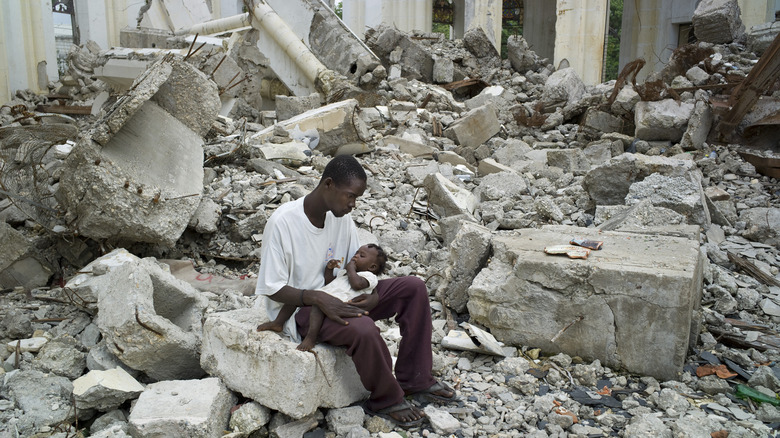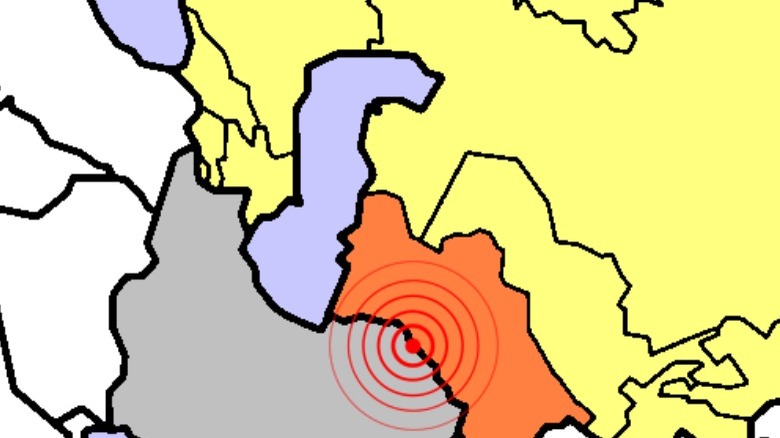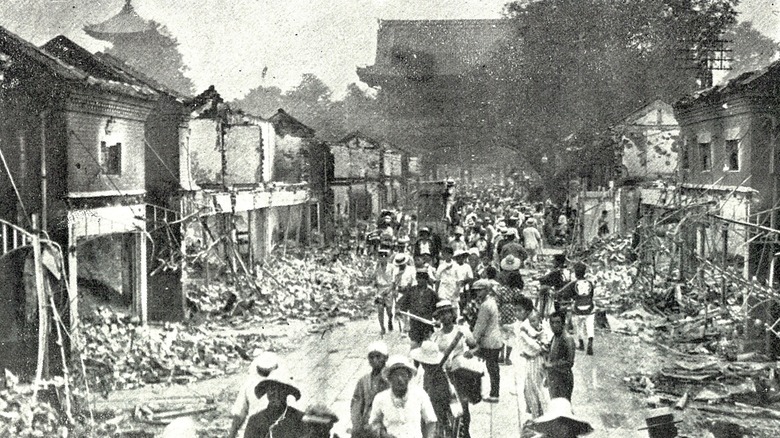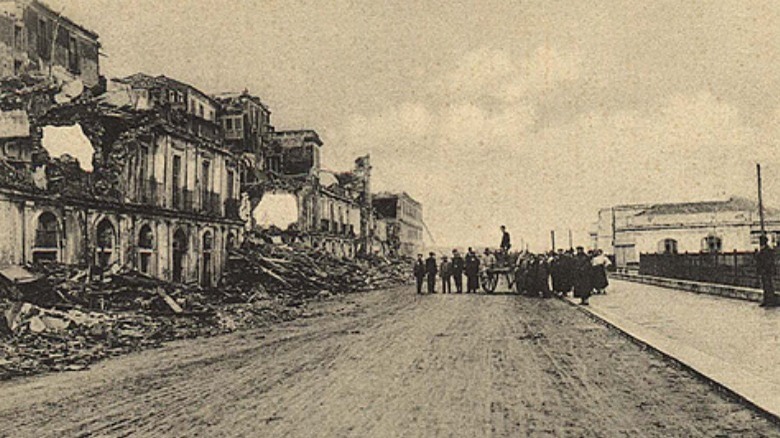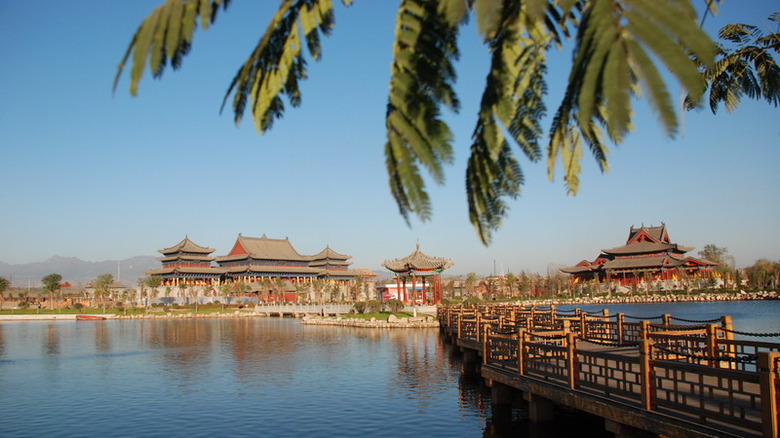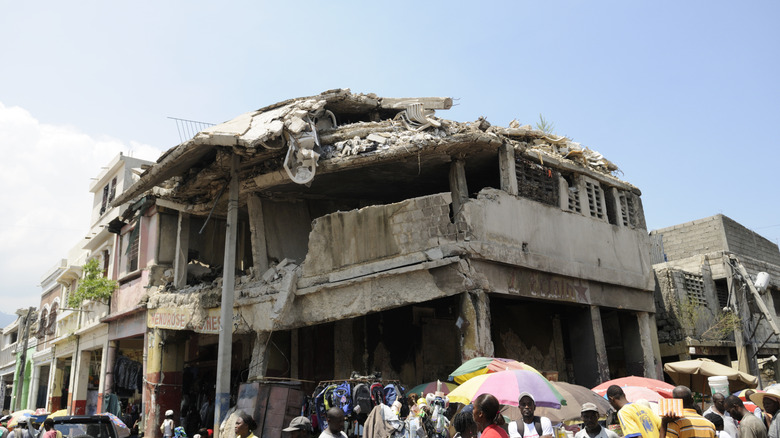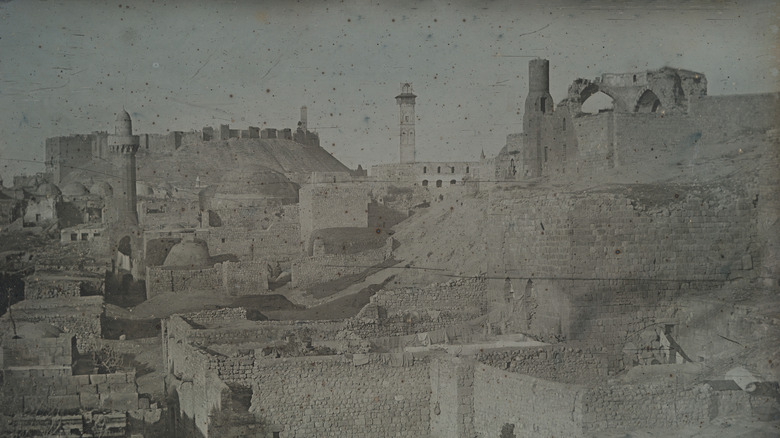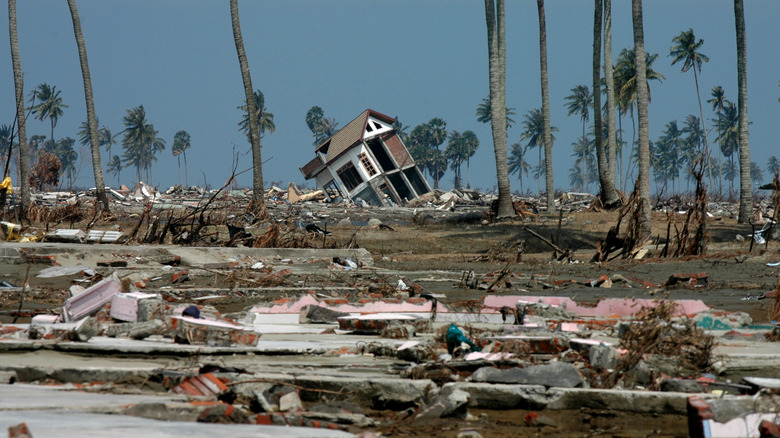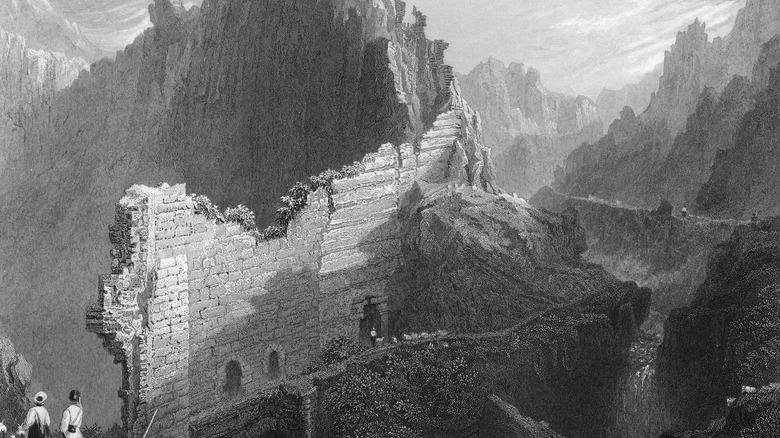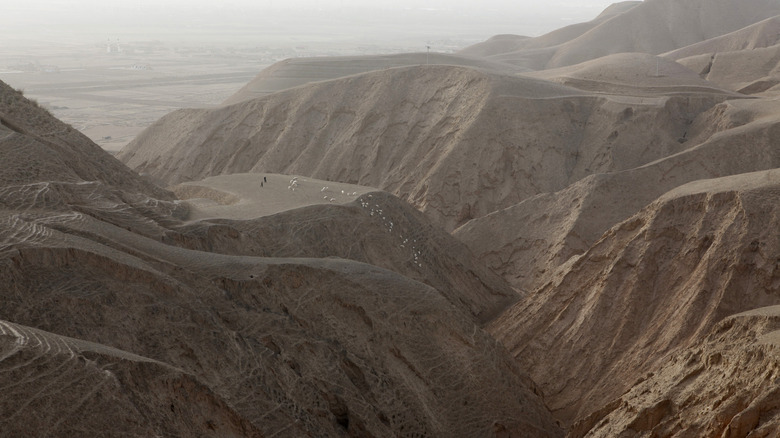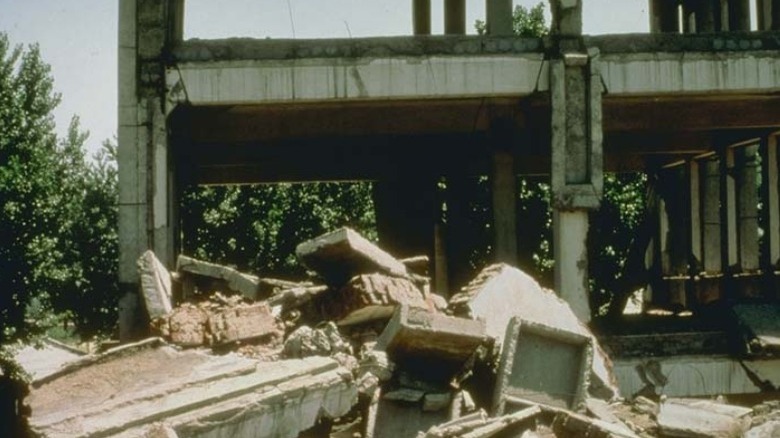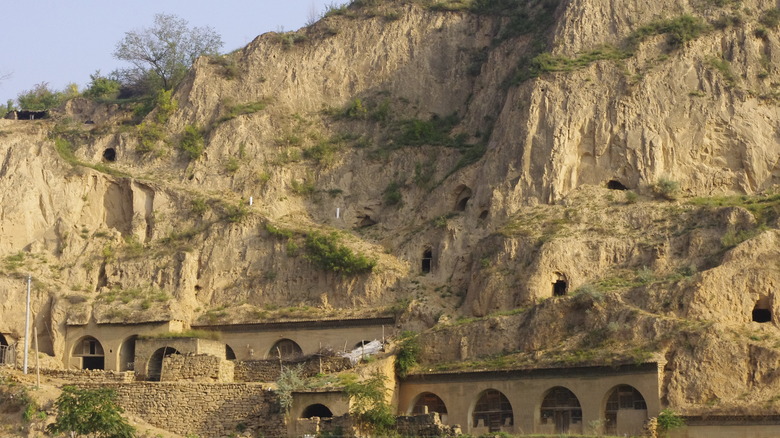The Most Devastating Earthquakes Of All Time
Although the Richter scale of measuring earthquake magnitudes wasn't devised by Charles F. Richter until 1935, people have been recording earthquakes for thousands of years, and human history has seen its fair share of devastating earthquakes. Whenever the tectonic plates start to shift, cities are liable to be destroyed and tens of thousands can lose their lives. Sometimes, the majority of the destruction can even occur in the aftermath of the earthquake, either in the form of tsunamis or failures of relief aid.
Although the Richter scale technically has no upper limit, the strongest earthquake ever detected, the 1960 Valdivia Earthquake in Chile, had a magnitude of 9.5, equivalent to more than 475 million tons of TNT. But even when an earthquake isn't topping the Richter scale, it can still do an incredible amount of damage.
The first earthquake classification system was devised in the 1780s by Domenico Pignataro, and in his classification system, which ranged from slight to very strong, the Calabrian earthquake of 1783 was described as violent. Considering that 29,500 people died during the 1783 Calabrian earthquake, how would Pignataro have described tenfold devastation? These are the most devastating earthquakes of all time.
The 1948 Ashgabat earthquake
In 1948, Turkmenistan was struck by one of the biggest earthquakes in its history. But it would be almost half a century before the real devastation of the earthquake was revealed. The earthquake struck in the early hours of October 6, 1948, around two in the morning, near the city of Ashgabat, located on the Turkmen border with Iran. Although the earthquake lasted just 10 seconds, it was incredibly destructive.
The earthquake has been described as measuring between 7.3 and 9.0 magnitude on the Richter scale. The death toll of the earthquake was also initially reported to be around 10,000, but in 1988, was revised to 110,000 and later estimated to be over 175,000. Ultimately, the reason for this discrepancy comes from the fact that the Soviet media during the Stalinist regime heavily suppressed and minimized reports of the earthquake, per the Encyclopedia of Disaster Relief.
The earthquake leveled the city, bringing down almost all brick buildings, telephone and telegraph wires, railways, and utility systems. But according to "All Shook Up" by Nigel Raab, Moscow's Pravda newspaper refused to print a total death toll and didn't even estimate a death toll. However, they did give estimates for the earthquake in Meshed, Iran, "which it falsely treated as a separate geological event." In "Inside Central Asia," Dilip Hiro writes that Moscow took advantage of the leveled city to completely rebuild with a grid layout. This process was repeated after the Tashkent earthquake of 1966.
The 1923 Great Kanto earthquake
On September 1, 1923, the Great Kantō earthquake hit the Kantō Plain of Imperial Japan. Both the cities of Yokohama and Tokyo were devastated, but the consequences of the earthquake would turn out to be just as destructive, if not more so.
The earthquake hit just a few minutes before noon on September 1, measuring 8.2 on the Richter scale. And because many people were cooking food at the time, the overturned cooking stoves caused fires to spread and engulf communities. Smithsonian Magazine writes that the flames were fueled by the wooden houses and winds, and with the water mains destroyed, the fire department was unable to provide any relief. At one point, a 300-foot-tall "fire tornado" surrounded up to 44,000 people who'd fled towards the Sumida River. Out of those 44,000, only 300 survived.
Due to both the earthquake tremors and the resulting fires, 90% of the homes in Yokohama were destroyed, and "60% of Tokyo's population" were suddenly houseless, writes ThoughtCo. The 40-foot tsunami caused by the earthquake was also responsible for a great deal of damage. In total, the death toll was estimated to be over 140,000 people. And unfortunately, the destruction and devastation didn't end after the tremors ceased and the fires were subdued. In the aftermath of the earthquake, thousands of Korean people in Japan were massacred under the guise of Martial Law, per The Enemy Within.
The 1908 Messina earthquake
On December 28, 1908, southern Italy was struck by the most destructive earthquake to ever hit Europe, measuring 7.1 to 7.5 on the Richter scale. With an epicenter in the Messina Strait between Sicily and Calabria, the resulting tsunami also destroyed dozens of cities on the Italian coast. Death toll estimates range from 75,000 to 200,000 but the overall devastation caused by the earthquake is indisputable. Cities like Messina in Sicily saw their population "reduced to only hundreds," PBS writes, and few buildings were left standing. Afterwards, according to "Fault Lines" by Giacomo Parrinello, reporters gathered to describe "the terrible stench and the sounds of the dead city, and the scenes of despair witnessed among the survivors."
The survivors of the earthquake were relocated to cities around Italy. Some were even forcibly displaced to America, such as the 850 people who were transported to New York City on the cargo ship "Florida" in 1909. Tragically, the "Florida" would go on to collide with the "Republic," a luxury passenger liner, during its voyage, resulting in the deaths of three people on the "Florida."
According to Temblor, the fault responsible for the 1908 Messina earthquake was finally identified in 2019.
The 1303 Hongdong earthquake
The 1303 Hongdong earthquake is believed to have been the first magnitude 8.0 earthquake recorded in North China, then part of the Mongol Empire. But although recent research has shown that the 1303 Hongdong earthquake was likely closer to 7.0, it's still considered to be one of the deadliest earthquakes in human history.
The Hongdong earthquake hit on September 17, 1303, near the Hongdong County, but damage stretched across "45 counties of three provinces" and more than 150 miles from the epicenter, according to "Intraplate Earthquakes," edited by Pradeep Talwani.
It's estimated that between 270,000 and 470,000 people died as a result of the earthquake. Taiyuan and Pingyang saw the most damage, with tens of thousands of buildings collapsing onto thousands of people, writes History Draft. In Zhaozheng, Hongdong, and Huo County, many of the buildings, including temples, civilian buildings, and official buildings, were completely leveled. Many of the temples, like the Dragon King Temple, were rebuilt in the years following the earthquake.
The 2010 Haiti earthquake
In the aftermath of the 2010 Haitian earthquake, many people described it "as if a bomb went straight to the heart of Port-au-Price," per NPR, and they weren't far off. Measuring a magnitude of 7.0, the earthquake caused an immense amount of damage, as did the aftershocks that followed up to a week later. Although estimates vary, up to 300,000 people died, if not more so, and over 2 million people were displaced, per CNN. The earthquake also created two tsunamis, which caused waves to travel inland and damaged hundreds of thousands of houses.
Near the epicenter, up to 90% of the buildings were reduced to rubble. And across the country, more than 50% of buildings, including hospitals and schools, were destroyed or damaged.
The catastrophe caused by the earthquake was unfortunately exacerbated by man-made crises that came after the earthquake. The UN response to the earthquake ended up bringing a cholera epidemic along with them, according to The Guardian, and most of the aid that was raised and meant to go to the Haitian people ended up disappearing into the relief organizations like the Red Cross, who claimed to be helping but had little evidence to show for it. Ultimately, less than 1% of relief funds went to "Haitian NGOs and businesses."
The 1138 Aleppo earthquake and the 1139 Ganja earthquake
During the 12th century, Southwest Asia was hit by numerous devastating earthquakes, including the 1138 Aleppo earthquake in Syria and the 1139 Ganja earthquake, which affected the Seljuk Empire and the Kingdom of Georgia, now considered to be Azerbaijan and Georgia. However, historians continue to debate as to whether or not these earthquakes were individually destructive or if their devastations have been conflated.
According to Annals of Geophysics, Islamic historian Ibn Taghribirdi wrote that the 1138 earthquake in Aleppo resulted in the deaths of 230,000 people. Ibn Taghribirdi was the first historian to mention the 230,000 death toll in Aleppo, but other writers attribute this loss of life to the 1137 earthquake in Jazira plain and the 1139 earthquake in Ganja.
However, even if the death toll of the 1138 Aleppo earthquake is misattributed, this doesn't mean that it wasn't destructive, especially since it occurred during the Crusades, "in which most sites had already suffered from warfare and previous earthquakes." The castle of Harim and its church completely collapsed, as did Athareb and its citadel. Most sources agree that Aleppo was destroyed, but there's a dispute as to whether or not "the shock reached its maximum at Aleppo." Since residents in Aleppo also felt the foreshocks, some were able to evacuate to the country. However, the resulting landslides triggered by the earthquake also contributed to the loss of life.
The 2004 Boxing Day Tsunami
Known as the Christmas or Boxing Day Tsunami, the earthquake that shook the Indian Ocean in 2004 was one of the most powerful ones ever recorded, triggering one of the largest tsunamis in the past half-century. According to USGS, the earthquake occurred around eight in the morning on December 26, 2004, between the Indian and the Burmese tectonic plates, measuring a magnitude of 9.1 on the Richter scale.
The earthquake reportedly displaced the seabed upward by over 60 feet, opening a new rift and releasing "an unimaginable amount of energy – equivalent to approximately 550 million times the atomic bomb dropped on Hiroshima in 1945," according to ThoughtCo. The earthquake subsequently caused a tsunami that hit northern Sumatra in Indonesia just 30 minutes after the main quake and reached Sri Lanka approximately 2-3 hours later. The affected waters ended up reaching as far as the east coast of Africa. Reuters reports that the subsequent tsunami killed over 230,000 people in 13 different countries, including Indonesia and Thailand, and over half a million people were displaced and rendered houseless. The Northern Aceh province of Sumatra saw the most devastation, with over 128,000 people reported dead.
The 2004 Indian Ocean earthquake and tsunami was especially devastating because, unlike the Pacific, the Indian Ocean didn't have a tsunami detection system in place. However, the Indian Ocean Tsunami Warning System has since been established.
The 526 Antioch earthquake
In 526, the city of Antioch, Syria in the Byzantine Empire, now considered part of Turkey, was struck by a massive earthquake that destroyed the "Rome of the East." According to The Historical Earthquakes of Syria, the earthquake hit Antioch around midday on May 20, 526, leading to the collapse of numerous buildings and "causing a great fire." And the aftershocks lasted 18 months after the main quake.
Modern scientists believe that the earthquake likely measured a magnitude of 7.0 and the death toll is estimated to be around 250,000 people. The death toll noted by contemporary historians was also between 250,000 and 300,000 and it's believed that this number is accurate due to the fact that Antioch was celebrating its annual festival for Ascension Day. This would've brought in Christians and travelers from across the Byzantine Empire, according to Weather Pro Live. Thousands of people died in the Great Church alone, which was destroyed during one of the aftershocks of the 526 earthquake, per Encyclopedia of Disasters. The destruction was so terrible that "everyone decided that the earthquake was a punishment from God."
After the destruction of Antioch, Emperor Justinian I spent "two thousand pounds of gold" to partially rebuild the city.
The 1920 Haiyuan earthquake
On December 16, 1920, the Gansu province in China was hit by an earthquake measuring between 7.8 and 8.5 on the Richter scale. With an epicenter located in Haiyuan, today part of the Ningxia Hui Autonomous Region, the earthquake affected at least "four counties and scores of villages" within a 125-mile radius, according to That's Magazine. Over 675 landslides were also caused by the earthquake.
Although buildings near Lanzhou were "surprisingly resilient," hundreds of thousands of people lost their homes in rural communities like Haiyuan and Guyuan, where many people lived in yaodongs, or "house caves," dug out of loess, writes Disaster History.
In total, it's estimated that over 270,000 people died as a result of the earthquake. In Haiyuan alone, over 73,000 people lost their lives. But the massive death toll wasn't solely due to collapses during the main earthquake. After the quake, it took some days to figure out exactly where the earthquake had occurred, which delayed the dispatch of recovery aid. And even when it became possible to send aid, the Beiyand government "pocketed great portions of relief funds." In addition, because the earthquake occurred in the middle of winter and rendered thousands of people without shelter, many ended up dying due to the extreme cold. And with aftershocks continuing for three years, many feared to build anything new.
The 1976 Tangshan earthquake
The deadliest earthquake of the 20th century occurred on July 28, 1976, hitting Tangshan, China at 3:42 AM. Because it was the middle of the night, many people were sleeping and didn't have the chance to seek shelter, but those who were awake noticed "thousands of electric flashes" in the sky. And although the earthquake lasted a maximum of 16 seconds, those 16 seconds were devastating.
The main quake was measured at 7.8 magnitude and in the afternoon an aftershock of 7.1 magnitude hit as well. Tragically, those who were still trapped under the rubble by the time the aftershock hit would never make it out. According to The Great Tangshan Earthquake of 1976, 85% of the buildings collapsed during the earthquake and numerous systems broke down, including the electrical power, water, sewage, telephone, and radio communications. And because it was believed that the probability of an earthquake hitting Tangshan was low, nothing was built to be earthquake resistant.
ThoughtCo writes that estimates for the death toll range between 240,000 and 700,000: "In 7,218 households, all members of the family were killed by the earthquake." And although the Chinese government gave Tangshan and Tianjin "government subsidies for reconstruction," the rebuilding prioritized factories and mines. As a result, there were still many people living in temporary housing as late as 1982. The reconstruction of Tianjin lasted until 1991.
The 1556 Shaanxi earthquake
The 1556 Shaanxi earthquake is believed to have been the most devastating earthquake in human history. Occurring on January 23, 1556, in the Shaanxi and Shanxi provinces and estimated to have been magnitude 8.0, the epicenter was reported to have been around Huaxian in Shaanxi, with damage radiating up to 250 miles out.
According to the "Encyclopedia of Disasters," because most of the population lived in yaodongs (cave houses), many people were killed as the loess "disintegrated under the earthquake's pressure and shaking." In addition, many were killed by the subsequent landslides after the earthquakes, and the total death toll is estimated to be around 830,000, or about 60% of the region's population. It's believed that one-third of the deaths were caused by building and cave collapses, and JGR Solid Earth writes that the "remaining two-thirds [are] thought to have perished through resulting famine and disease."
Although the Shaanxi Earthquake of 1556 wasn't one of the most powerful earthquakes in history, its subsequent devastation remains unmatched as of 2022. According to History Daily, the earthquake was so powerful that it even managed to change the course of rivers, causing massive flooding and destruction, and even "leveled mountains." Hundreds of cultural artifacts were also destroyed in the collapse of museums, and fires devastated communities for days.
